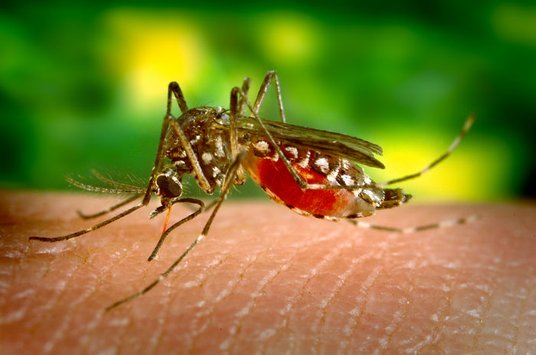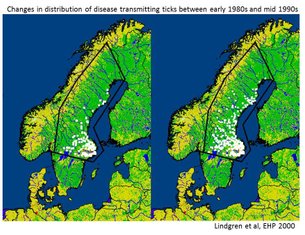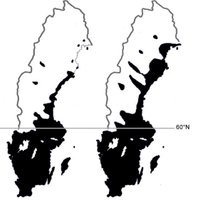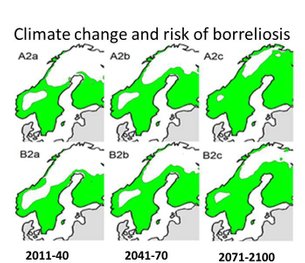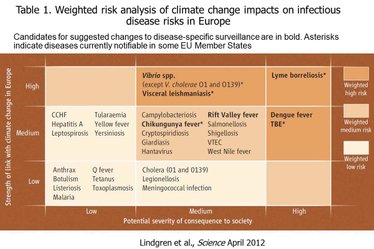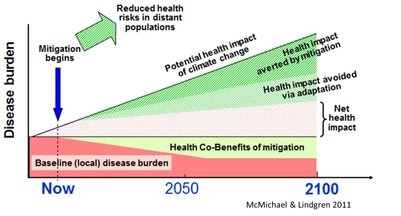Elisabet Lindgren Health and the Global Environment
Photos: Christian Barrette/flickr, Lei Han/flickr
Health Effects of Global Environmental Changes
Our transformation of the planet is threatening our health and well-being.
Today's world is becoming increasingly interconnected. Local activities cause changes in global systems, such as the climate system, that in turn affect human health and well-being - either directly, or indirectly through multiple systemic linkages and processes. The magnitude and type of health effects that will occur depend on local vulnerability, resilience and adaptive capacity.
The increasing global travel and trade are spreading pathogens and disease vectors rapidly around the globe, contributing to the re-emergence of several infectious diseases and emergence of new threats.
More people are now living in cities than in rural environments. This puts development of healthy sustainable cities high on the agenda. A cost-effective sustainable trajectory for urban planning would be to choose solutions that have multiple benefits with positive effects on health and well-being. Nature-based solutions are emerging choices to consider since they are both sustainable and often have multiple benefits, including health co-benefits.
In order to counteract future changes in disease burden and the risk of emerging new threats from global environmental changes we need to work transdisciplinary; perform local risk and adaptation assessments in a cross-sectoral context with local stakeholder involvements; and evaluate best choices of sustainable innovations, policies, and actions that contribute to better health for present and coming generations.
Photo: James Gathany/ flickr
Lindgren's main focus areas:
- Climate change and health
- Sustainable healthy cities
- Sustainable healthy diets
CLIMATE CHANGE AND HEALTH
Climate change will, directly and indirectly, have an impact on burden of disease, contribute to the emergence and re-emergence of disease, and affect people's well-being, livelihoods and survival. The impact of climate change on human health and well-being will vary depending on local conditions, vulnerabilities, resilience, and adaptive capacity of society.
Health effects of climate change are associated with:
- changes in the frequency and intensity of extreme climate events
- changes in seasonal climate affecting the ecology, transmission and geographical distribution of many infectious diseases, as well as the occurrence of allergenic pollen
- impacts of climate change on water quality and quantity, food safety and security, and air quality
- other impacts of climate change on the natural and human-made environment
- impacts of climate change that affect infrastructure and important services of the society
Climate change often interacts with other drivers to cause consequences for people's health and well-being. The research field on climate change and health aim at
- understanding current relationships between climate factors and health
- identify changes in risk of disease from recent variations/ changes in climate
- develop theoretical or mathematical scenario models of future health effects
Climate change and health research often needs to be transdisciplinary but also includes basic science. Local risk and vulnerability assessments with a science-based policy focus need to include different scientific disciplines and sectors of society as well as local stakeholders.
Society would benefit from adopting climate change mitigation/adaptation solutions that have multiple benefits with additional positive impacts on public health, when possible.
Lindgren's main focus areas related to climate change and health cover:
- Observed health-related changes from climate variations and climate change
- Climate change and changing health risks and emerging threats
- Risk, vulnerability, and adaptation assessments
- Bridging the gap between science and policy
- Science-based solutions with multiple benefits
Observed changes in the northern latitude distribution of disease-transmitting ticks
Changes in risk areas of Lyme borreliosis for 2011-2040, 2041-2070, and 2071- 2100.
Figure from: Jaenson & Lindgren, 2011
Risk assessments
Changing surveillance needs of infectious disease in Europe due to climate change.
Figure from: Lindgren et al, Science 2012
Bridging the gap between science and policy
Adaptation-mitigation health co-benefits.
Figure from: McMichael and Lindgren, JIM 2011
SUSTAINABLE HEALTHY CITIES
- Global environmental changes, globalisation, sustainable cities, and human health.
- Urban ecosystem services and human health.
- Nature-based solutions with health benefits.
- Sustainable city planning and transformation with human health in focus: Strategies and innovations with multiple benefits solutions that emphasis public health gains.
SUSTAINABLE HEALTHY DIETS
How can the world feed 9 billion people in a not too far future in a healthy and sustainable way?
We need to consider the whole food system, that is the whole chain from farm to fork, including agricultural practices, the food industry from production to retail, as well as consumer behaviour and waste handling. Local conditions, such as cultural, economic, ecological, and climatic aspects that affect the farm-to-fork chain needs to be considered.

